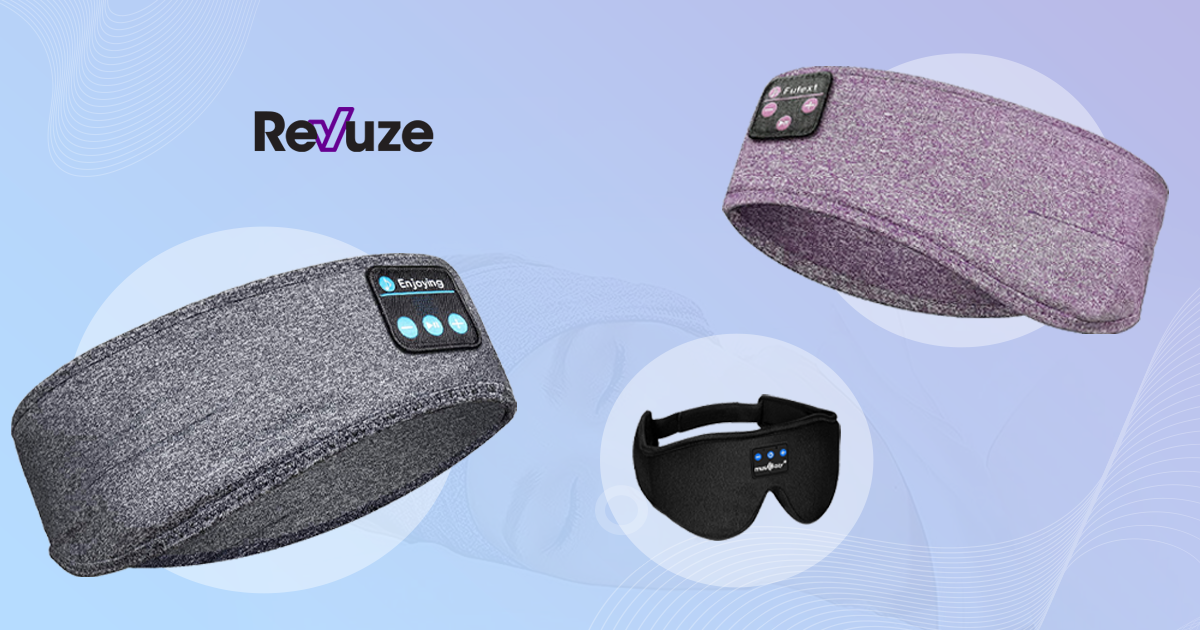What Are Sleep Headphones?
Sleep headphones are headphones designed to be used while sleeping and while you’re trying to fall asleep. Living in busy urban areas which have noise late into the night causes difficulty sleeping, leading to insomnia, depression and other major health issues. How do sleep headphones work? Well, they supposedly block out external noise to give you peace, while having the option to play something to listen to while you fall asleep.
Whether you want to listen to a podcast or just let your mind drift with music or ambient background noises, sleep headphones need to fulfill several criteria if you want them to do their job. Sleep headphones have also seen increasing use in ASMR, which shares a lot of similarities in terms of needs. More on the ASMR use case later.
The most important characteristics for sleep headphones

- They need to be comfortable: it’s difficult to fall asleep if you’ve got something digging into you.
- They need to be able to stay on when you toss and turn in your sleep; that is why regular old earbuds aren’t going to cut it.
- Ideally, they should be wireless, for both comfort reasons and safety, as it’s dangerous to sleep with anything you could potentially tangle yourself up in.
Bluetooth and other short-range linkages can help get around the wire issue, and there are plenty of alternate headphone designs that can get around the other two factors.
Some of those available on the market right now use a sleep mask as a base! It’s a clever use of multi-functional design that capitalizes on the fact that obstructing a user’s vision isn’t really a problem when they’re sleeping.
Are sleep headphones safe to use? As with any headphones, you might damage your hearing if you’re not careful or get tangled up in any wires, but they’re safe otherwise. Common questions such as “do sleep headphones emit radiation” and “do sleep headphones cause cancer” can be answered with a resounding no, this is pre-established, safe technology being used in a new way.
Google Trends: Sleep Headphones Are Gaining Momentum

According to data by Google Trends, searches for sleep headphones have been on a fairly steady upwards trend over the past few years.
One pattern we noticed is that they seem to have their seasonal peaks around November, likely because they make a great holiday gift, and as the market has grown so too has interest in it.
Google also shows that some of the highest search rates come from Chicago, New York and Los Angeles.This does not come as a surprise, as demand increases in busy metropolises, where there often is lots of noise late at night due to the active nightlife and constant presence of public transportation.
[banner_text text=”Read our report on the Apple AirPods Max” button_text=”Download the report” button_link=”https://www.revuze.it/resources/apple-airpods-max-one-year-later/”]
The Best Sleep Headphones According To Our AI
Here at Revuze, we perform our market research using innovative AI tools. For this article, we’ve extracted some useful insights from our product insights engine, Sentimate. Here’s a selection of the 3 top picks from the Sleep Headphones category that we’ve chosen to examine, and the reasons why they rank so highly with consumers.
Enjoying Eye Mask Headphones
Starting things off are the Enjoying sleep headphones are among the most comfortable on the market, according to reviewers. It also boasts a long battery life, high audio quality and the highest Performance rating in the category.
The Enjoying are currently in the No. 1 spot for customer sentiment in the category, boasting a Sentiment rating of 79%.
MUSICOZY Sleep Headphones Mask
The Musicozy sleep mask shaped headphones, rated highly in Comfort, Performance and overall Quality by reviewers.
While their Noise Cancellation properties divide users, it’s generally agreed that that feature works just fine when the headphones are playing, making them a stand-out in the category and ranked highly by our AI with a Sentiment rating of 68%.
Fulext Sleep Headphones Mask
Coming in third is the Fulext Bluetooth Sleep Mask, which rates extremely highly in the Applications part of reviews thanks to its easy bluetooth connectivity and overall versatility.
Its slim design makes it usable for both sleeping and as a headband whilst working out, with consumers also rating it highly for its audio quality and comfort – both crucial aspects of sleep headphones.
The highest scores for customer satisfaction came when rating music listening experience, and oddly enough the color. Maybe purple is in this year?
Sleep Headphones SWOT Analysis
A SWOT analysis can tell you a lot about your product. It’s not easy to do a SWOT for a product category as a whole, but by looking at general trends that seem to pop up you can roughly get an idea of where the industry might focus next.

Strengths
Strengths are what’s good about your product. They’re solid features that consumers will rate highly; you shouldn’t change them unless you’re sure the resulting feature will be an overall improvement.
Taking the Fulext sleep mask as an example, the strengths that sleep headphones tend to show are what you’d expect from a design focused on comfort. The material, smell, and how comfortable they are all rate highly, with noise cancellation as a feature also being above average.
Overall, the strengths seem to be features which were the main focus of the design, as you’d expect.
Weaknesses
Moving on to product weaknesses, these tend to vary depending on if you have a product designed exclusively for sleeping or one that markets itself as versatile. Weaknesses are things which are objectively bad for you, things that should ideally alter if you can.
The Enjoying for example has a standout weakness in Gaming Experience, which products intending for sleeping wouldn’t worry about.
If you look at the Musicozy sleeping mask, specialized in use whilst falling asleep, you see weaknesses in speaker quality and treble, meaning these headphones are not so great for higher pitched sounds.
Opportunities
Opportunities are factors which aren’t giving you an advantage, but could possibly be turned into Strengths with improvement or better marketing.
In the case of sleep headphones a fair few of them list battery life as an opportunity, meaning any brand who improves theirs will gain a competitive advantage.
Other prominent opportunities include connectivity, how easily the product connects via bluetooth, WiFi etc. customization opportunities and audio quality. In the case of the Enjoying headphones audio quality is actually a Strength instead, representing their advantage over others in the market.
Threats
Threats are the inverse of Opportunities, things which aren’t quite weaknesses yet but may well get there. This can be because of changing consumer desires, competition getting a leg up on you by improving their products, etc.
Threats to the sleep headphones industry seem to be mainly focused around sizing and fitting issues, noise cancellation issues, and in the case of the multi-use headphones, call quality. A few products also mention issues with the accessories such as the charging cord, cases and earbud adaptors.
[banner_text text=”Perform a SWOT Analysis with Sentimate” button_text=”Get started” button_link=”https://sentimate.com/signup/”]
A Window of Opportunity: Sleep Headphones for ASMR
ASMR, or Autonomous Sensory Meridian Response, is a massive Internet phenomenon that’s kicked off in recent years. For those of you who don’t know what this is, imagine someone whispering in your ears. It provokes a certain kind of tingling sensation along your back, and that’s exactly what ASMR is describing.
As both microphones and speakers have gotten better it’s become more and more realistic to record voices speaking in low volumes without distorting quality, hence the rise of ASMR videos online which aim to stimulate this response in the listener.
Sleep headphones have seen an uptick in popularity ever since users realized their applications for ASMR, with an eye on noise reduction and sound quality to provide an experience that most closely matches the whispers they seem to crave. Sleep headphones target ASMR users by different metrics to those who wish to use them for sleep, but they are similar enough that a separate product doesn’t need to be made.
 All
Articles
All
Articles Email
Analytics
Email
Analytics




 The above is real data taken from our product insights engine, showing the top ten products in the Drones category for April 2022.
The above is real data taken from our product insights engine, showing the top ten products in the Drones category for April 2022. 